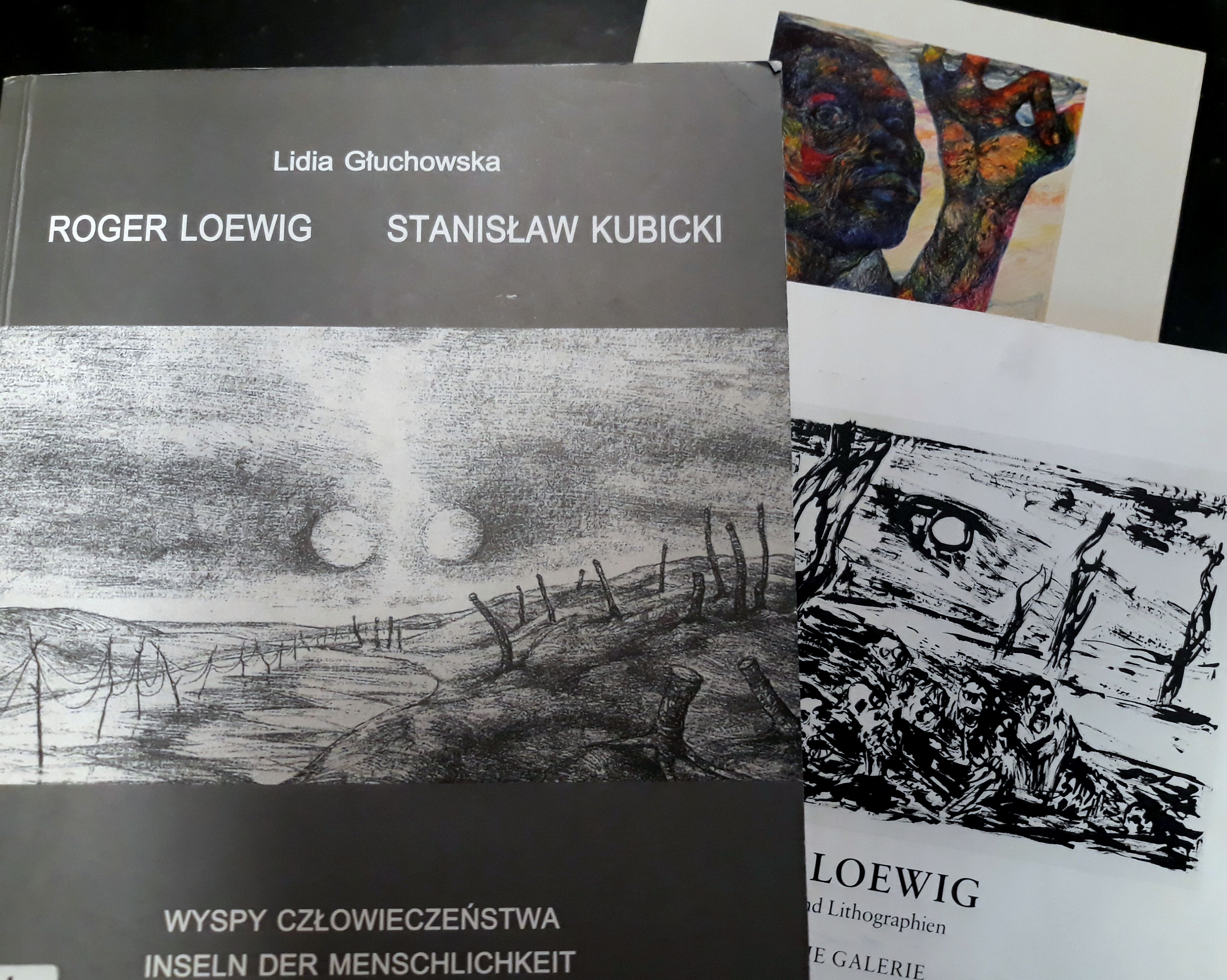The construction of the Berlin Wall in 1961 had a strong impact on Roger Loewig, resulting in a series of artworks. In the same year, he drew the series 'From German history’ (later renamed 'From German History and its present’). Soon after in 1963 he showed drawing from this series on his first privately organised exhibition in the house of the priest Damus in Berlin-Baumschulenweg. The house was a well-known meeting point for students from East- and West-Berlin. With this occasion, Loewig exhibited artworks depicting the theme of the Berlin Wall. The immediate consequence of this event, triggered by the theme of the artworks, was the imprisonment of the artist. After almost one year, he was brought to charge for 'treacherous propaganda’. Most of his confiscated works, including paintings and manuscripts, are considered until present-day as still missing or have been destroyed. Loewig was ransomed in 1964 with the support from Western Germany and released in the GDR.
Following his release in 1964, the artist lived predominantly in his partner’s apartment Creszentia Troike, and eventually also moved together. Loewig denied the return to his apartment which was subjected to Stasi searching. He traveled often to his friends in the countryside in Bad Belzig. Here retreated in isolation, the artist spent a great amount of time drawing and painting.
In 1965 Loewig was accepted in the Union of Artists, allowing him to officially carry on with his artistic production. Yet mid-1965 constrained by scarce economic resources and space limitation, Loewig stopped painting and focused on drawings. Once granted access to the printing machines of the Union of Artists he started exploring the technique of lithography. During this period numerous artworks have been illegally transported abroad or into Western Germany, and eventually privately purchased and exhibited. In this direction, the role of his partner Creszentia Troike, who actively engaged in promoting the artist artworks has to be noted. Following her engagement and with the support of the employees from the National Museum in Warsaw was organised in 1966 the first public exhibition of the artist in collaboration with the Gesellschaft der Freunde der Bildenden Künste [Society of Friends for Fine-arts]. On this occasion, numerous drawings and lithographs have been shown.
In 1966 a close group of friends initiated in Bonn the association which aimed at internationally promoting the artist and providing economic support. The association played an exponential role in raising awareness on the artistic production of the artist and facilitated private purchases and exhibitions.
Loewig artworks were shown on various exhibitions organised in several Western German cities, among which in West Berlin together with the Fine arts Academy, in Munich with the Neuer Münchener Gallery, and in Hannover with the Kunstverein Hannover [Art Society]. Single exhibitions were organised in Freiburg Gallery and in Hannover with the Gemeinschaftshaus des universitären Studentenwohnheims [Community Centre of the University Dormitories] and even in the United States.
In the GDR he did not really publicly exhibited his artworks. It was only 1967 when Loewig officially exhibited together with the Kunstkabinett [Cabinets of Wonder] at the Institut für Lehrerweiterbildung [Institute for Teachers Vocational Training] in Berlin Pankow. Yet Loewig never managed to really establish himself as a prominent artist in the GDR.
Following his departure in 1972 from the GDR, he chose to live together with his partner Creszentia Troike in the 'Märkisches Viertel’ neighborhood, close to the wall. In the same year it was organised his first single major exhibition 'Dunkelland’ [Dark country] in collaboration with Brusberg Gallery in Hannover. Yet the exhibition did not find a major success. Moreover, the artist understood that even in West Germany he stood in opposition to the dominant political and cultural developments. Despite that further single and group exhibitions were organised in West Germany. In addition, his artworks continued to be purchased by museums and galleries.
During the 1980s his literary works and few prose texts which have not been confiscated by the Stasi have been published in West Germany. Internationally he contributed in 1982 to the exhibition '10 Jahre Malerpoeten’ [10 years Painter Poets] shown in the Museum for Contemporary Art in Mexico City. In 1983 the same museum has put on display his single exhibition. In 1986 a major exhibition oragnised by the National Museum in Warsaw put on display a series of drawings and lithographs, which were eventually acquired by the museum. Based in Western Germany, the artist continued drawing and realised also few lithographs. However, Loewig rejected being called a GDR artist and continued identifying himself as a German artist.
Despite his departure from the GDR and being strictly prohibited entering the GDR- except few occasions-, Loewig continued nurturing his friendships. Following the fall of the Berlin Wall and German Reunification, Loewig remained skeptical towards political developments. He took on numerous travels in Central and Eastern European countries.
In 1992 Loewig was invited to exhibit as the first German artist his artworks in the State Museum of the former concentration camp museum in Auschwitz-Birkenau. The exhibition included among others the lithograph series under the name 'Epitafia’. Shortly before his death in 1997 his artworks were included in the major exhibition 'Deutschlandbilder’ organised in Martin-Gropius Bau in Berlin.
Following the death of the artist, the Roger Loewig Association founded in 1998 in Frankfurt-Oder, actively engaged in managing the legacy of the artist. It is thanks to its contribution that the artistic legacy of Loewig was entrusted in 2000 for preservation to the Federal Foundation for the Reappraisal of the SED Dictatorship. The aim of the Roger Loewig Association is not only to preserve the artistic legacy of the artist, but also to facilitate the access of the collection to a wider audience.
Loewig’s literary and biographical works are currently on hold at the Academy of Arts in Berlin.

